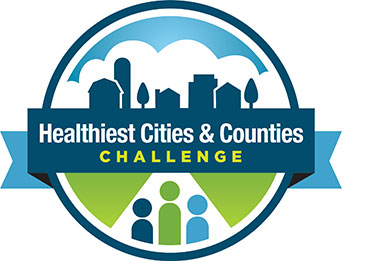 The most powerful resource in enacting lasting, positive change in communities are its residents — and the participants in the Healthiest Cities & Counties Challenge have proven that again and again.
The most powerful resource in enacting lasting, positive change in communities are its residents — and the participants in the Healthiest Cities & Counties Challenge have proven that again and again.
Now a year in, the Challenge teams have made in-roads in their communities and have set the stage for change, as some reported from a halfway-point progress update during a Monday APHA 2021 session. The goal of the challenge, funded by the Aetna Foundation and led in partnership by APHA, the National Association of Counties and Healthy Places by Design, is to improve access to health services and foods that support healthy eating patterns.
Some of the key achievements from the first year include:
- doubling the number of attendees at community convenings;
- engaging nearly 400 partner organizations across 20 communities; and
- adding 60 new food access points and six new health services access points.
“We have learned that it is essential to co-create solutions with residents and make sure that they are part of the decisionmaking table,” said Mike Bulger of Common Ground Health in Rochester, New York.
Bulger and his cross-sectional team in Rochester created a resident food policy council that is made up of and responds to members of the community. Their success has come from a design that “centered resident voice and shifted power to members of the community.”
 “While our employees are content experts…the people who navigate the systems and environments in our communities, they have a better appreciation of the full-context of their own health,” Bulger said.
“While our employees are content experts…the people who navigate the systems and environments in our communities, they have a better appreciation of the full-context of their own health,” Bulger said.
The public health advocates were not the only ones who recognized the power and utility of having a community-led council. In May, the Rochester City Council voted to recognize the new Food Policy Council and to send a representative to join it as a liaison.
Empowering stakeholders was a reoccurring theme the teams discussed during the roundtable session. And one doesn’t have to look far to create a city-sized effort to find communities to uplift.
In New Brunswick, New Jersey, Elijah’s Promise, which provides more than 30,000 meals to residents per month and has graduated hundreds of culinary students, has found success in supporting the youth in their communities — not a city or their neighborhood, but their school community.
 “The people who consume school food should share in the power to make decisions about school food,” said Jason Flatt. “Most students have zero say in the food they are served daily, sometimes several times a day for 12, 13-plus years.”
“The people who consume school food should share in the power to make decisions about school food,” said Jason Flatt. “Most students have zero say in the food they are served daily, sometimes several times a day for 12, 13-plus years.”
The program educates students on food systems and then supports them in advocating for changes to the menu.
To keep up with the Healthiest Cities and Counties Challenge, visit healthiestcities.org. You can also read coverage of the challenge in the July 2021 issue of The Nation’s Health.
Screen shot of Mike Bulger's session presentation and Jason Flatt speaking during the session courtesy Arianne Noorestani